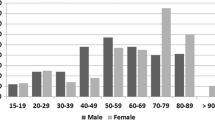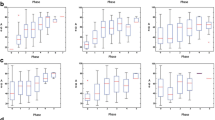Abstract
The classical age indicators of the innominate have been the pubic symphysis and auricular surface. However, recently, the acetabulum has been highlighted as an indicator of adult age, with applicability in young, middle-aged, and older adults. The Rissech acetabular method was developed in a Portuguese population and tested in European and European-Americans, giving estimates within 10 years of age in more than 89% of the sample. The main goal of this paper is to test the Rissech acetabular method in a modern South American sample. The material used for the study was 184 women and 378 men from a Colombian-documented skeletal collection. The obtained morphological scores from the acetabulum were analyzed through the IDADE2 web page, a Bayesian statistical program that estimates a relative likelihood distribution for the target individuals, produces age estimates, and provides 95% confidence intervals. Results showed this method is useful in the modern Colombian population with an average absolute error of 10.63 years in females and 9.44 years in males. These errors are similar to those obtained in other European and North American samples when this method was performed and similar or lower than those obtained when the 3 classical aging methods (Suchey-Brooks, Buckberry-Chamberlain, and Lovejoy) were applied in the same collection (absolute error: 10.29 years ♀ and 9.05 years ♂ in Suchey-Brooks, 12.5 years ♀, and 12.17 years ♀ in Buckberry-Chamberlain, and 13.54 years ♀ and 10.99 years ♂ in Lovejoy). Although Rissech’s method was developed in a Western European sample, the results of this study indicate its applicability in modern Colombian samples with reasonable accuracy.





Similar content being viewed by others
References
Kemkes-Grottenthaler A (2002) Aging through the ages: historical perspectives on age indicator methods. In: Hoppa RD, Vaupel JW (eds) Paleodemography. Age distributions from skeletal samples. Cambridge University Press, Cambridge, pp 49–72
Rissech C, Estabrook GF, Cunha E, Malgosa A (2007) Estimation of age at death for adult males using the acetabulum, applied to four Western European Populations. J Forensic Sci 52:774–779
Rissech C, Wilson J, Winburn AP, Turbón D, Steadman D (2012) A comparison of three established age estimation methods on an adult Spanish sample. Int J Legal Med 126:145–155
San-Millán M, Rissech C, Turbón D (2013) A test of Suchey–Brooks (pubic symphysis) and Buckberry–Chamberlain (auricular surface) methods on an identified Spanish sample: paleodemographic implications. J Archaeol Sci 40:1743–1751
Rissech C (2008) Estimación de la edad biológica de los restos subadultos. In: Gusi-Gener F, Muriel S, Olária C (eds) Nasciturus, infans, puerulus vobis mater terra: la muerte en la infancia. Servei d’Investigacions Arqueològiques i Prehistòriques, Diputació de Castelló, Castelló, pp 72–92
Usher BM (2002) Reference samples: the first step in linking biology and age in the human skeleton. In: Hoppa RD, Vaupel JW (eds) Paleodemography: age distributions from skeletal samples. Cambridge University Press, Cambridge, pp 29–47
Hens SM, Rastelli E, Belcastro G (2008) Age estimation from the human os coxa: a test on a documented Italian collection. J Forensic Sci 53:1040–1043
Nawrocki SP (2010) The nature and sources of error in the estimation of age at death from the skeleton. In: Latham KE, Finnegan M (eds) Age estimation of the human skeleton. Charles C. Thomas Publishers, Springfield, pp 79–101
Rissech C, Steadman DW (2010) The demographic, socioeconomic and temporal contextualisation of the Universitat Autònoma de Barcelona collection of identified human skeletons (UAB collection). Int J Osteoarchaeol 21:313–322. https://doi.org/10.1002/oa.1145
Sanabria-Medina C, González-Colmenares G, Osorio-Restrepo H, Guerrero-Rodríguez JM (2016) A contemporary Colombian skeletal reference collection: a resource for the development of population specific standards. Forensic Sci Int 266:577.e1–577.e4
Rissech C, Estabrook GF, Cunha E, Malgosa A (2006) Using the acetabulum to estimate age at death of adult males. J Forensic Sci 51:213–229
Rissech C, Winburn AP, San-Millán M, Sastre J, Rocha J (2019) The acetabulum as an adult age marker and the new IDADE2 (the IDADE2 web page). Am J Phys Anthropol 169:757–764
Calce ES, Rogers TL (2011) Evaluation of age estimation technique: testing traits of the acetabulum to estimate age at death in adult males. J Forensic Sci 56:302–311
Mays S (2014) A test of a recently devised method of estimating skeletal age at death using features of the adult acetabulum. J Forensic Sci 59:184–187
Rissech C, Appleby J, Cosso A, Reina F, Carrera A, Thomas R (2018) The influence of bone loss on the three adult age markers of the innominate. Int J Legal Med 132:289–300
Rougé-Maillart C, Jousset N, Vielle B, Gaudin A, Telmon N (2007) Contribution of the study of acetabulum for the estimation of adult subjects. Forensic Sci Int 171:103–110
Rougé-Maillart C, Telmon N, Rissech C, Malgosa A, Rougé D (2004) The determination of male adult age by central and posterior coxal analysis. A preliminary study. J Forensic Sci 49:1–7
San-Millán M, Rissech C, Turbón D (2017a) Shape variability of the adult human acetabulum and acetabular fossa related to sex and age by geometric morphometrics. Implications for adult age estimation. Forensic Sci Int 272:50–63
San-Millán M, Rissech C, Turbón D (2017b) New approach to age estimation of male and female adult skeletons based on the morphological characteristics of the acetabulum. Int J Legal Med 131:501–525
San-Millán M, Rissech C, Turbón D (2019) Application of the recent SanMillán-Rissech acetabular adult aging method in a North American sample. Int J Legal Med 133:909–920
Stull KE, James DM (2010) Determination of age at death using the acetabulum of the os coxa. In: Latham KE, Finnegan M (eds) Age estimation of the human skeleton. Charles C. Thomas, Springfield, pp 134–146
Venara A, Martrielle L, Godin M, Kerdat C, Deguette C, Chapard D, Rougé-Maillart C (2013) Estimation de l’âge d’un squelette au décès d’un sujet adulte en utilisant l’acétabulum et la surface auriculaire – Application sur la Terry Collection. La Rev Méd Légale 4:189–196
Winburn AP (2017) Skeletal age estimation in modern European-American adults: the effects of activity, obesity, and osteoarthritis on age-related changes in the acetabulum. PhD dissertation. University of Florida, Gainesville, FL
Winburn AP (2018) Validation of the acetabulum as a skeletal indicator of age at death in modern European-Americans. J Forensic Sci 64:989–1003
Miranker M (2016) A comparison of different age estimation methods of the adult pelvis. J Forensic Sci 61:1173–1179
Powanda A (2008) A comparison of pelvic age-estimation methods on two modern Iberian populations: Bioarchaeological and forensic implications. Master dissertation. New York University, New York, NY
Brooks ST, Suchey JM (1990) Skeletal age determination based on the os pubis: a comparison of Acsádi-Nemeskéri and Suchey-Brooks methods. Hum Evol 5:227–238
Lovejoy CO, Meindl RS, Pryzbeck TR, Mensforth RP (1985) Chronological metamorphosis of the auricular surface of the ilium. A new method for the determination of adult skeletal age at death. Am J Phys Anthropol 68:15–28
Buckberry JL, Chamberlain AT (2002) Age estimation from the auricular surface of the ilium: a revised method. Am J Phys Anthropol 119:231–239
Osborne DL, Simmons TL, Nawrocki SP (2004) Reconsidering the auricular surface as an indicator of age at death. J Forensic Sci 49:JFS2003348–JFS2003347
Calce ES (2012) A new method to estimate adult age-at-death using the acetabulum. Am J Phys Anthropol 148:11–23
Mays S (2012) An investigation of age-related changes at the acetabulum n 18th–19th century AD adult skeletons from Christ Church Spitalfields, London. Am J Phys Anthropol 149:485–492
Sanabria-Medina C (ed) (2016) Patología y antropología forense de la muerte: la investigación cientifico-judicial de la muerte y la tortura, desde las fosas clandestines, hasta la audiencia pública. Forensic Publisher, Bogotá DC, Colombia
Cunha E (1996) Osteoarthritis as an indicator of demographic structure of past populations: the example of a Portuguese medieval sample. In: Pérez-Pérez A (ed) Salud, enfermedad y muerte en el pasado. Consecuencias biológicas del estrés y la patología. Fundación Uriach, Barcelona, pp 149–155
Arnqvist G, Martensson T (1998) Measurement error in geometric morphometrics: empirical strategies to assess and reduce its impact on measures of shape. Acta Zool Acad Sci H 44:73–96
Bailey RC, Byrnes J (1990) A new, old method for assessing measurement error in both univariate and multivariate morphometric studies. Syst Zool 39:124–130
Siegel S (1956) Nonparametric statistics for the behavioural sciences. McGraw-Hill, New York
Lucy D, Aykroyd RG, Pollard AM, Solheim TA (1996) Bayesian approach to adult human age estimation from dental observations by Johanson’s age changes. J Forensic Sci 41:189–194
Falys CG, Schutkowski H, Weston DA (2006) Auricular surface aging: worse than expected? A test of the revised method on a documented historic skeletal assemblage. Am J Phys Anthropol 130:508–513
Murray K, Murray T (1991) A test of the auricular surface aging technique. J Forensic Sci 36:1162–1169
Sinha A, Gupta V (1995) A study of estimation of age from the pubic symphysis. Forensic Sci Int 75:73–78
Muñoz-Silva V (2019) Evaluación y desarrollo de cuatro métodos establecidos para la estimación de la edad adulta basados en los tres marcadores del hueso coxal en una muestra esquelética actual documentada de origen colombiano. PhD dissertation, Universitat de Barcelona, Barcelona.
Hens SM, Belcastro MG (2012) Auricular surface aging: a blind test of the revised method on historic Italians from Sardinia. Forensic Sci Int 214:209–2e1
Martrille L, Ubelaker DH, Cattaneo C, Seguret F, Tremblay M, Baccino E (2007) Comparison of four skeletal methods for the estimation of age at death on white and black adults. J Forensic Sci 52:302–307
Moraitis K, Zorba E, Eliopoulos C, Fox SC (2014) A test of the revised auricular surface aging method on a modern European population. J Forensic Sci 59:188–194
Mulhern DM, Jones EB (2005) Test of revised method of age estimation from the auricular surface of the ilium. Am J Phys Anthropol 126:61–65
Schmitt A (2004) Age-at-death assessment using the os pubis and the auricular surface of the ilium: a test on an identified Asian sample. Int J Osteoarchaeol 14:1–6
Djurić M, Djonić D, Nikolić S, Popović D, Marinković J (2007) Evaluation of the Suchey–Brooks method for aging skeletons in the Balkans. J Forensic Sci 52:21–23
Garvin HM, Passalacqua NV (2012) Current practices by forensic anthropologists in adult skeletal age estimation. J Forensic Sci 57:427–433
Rissech C (2021) The importance of human anatomy in forensic anthropology. EJA (in press)
Acknowledgments
We want to thank the Director of the National Institute of Legal Medicine and Forensic Sciences in Bogotá (Colombia) for access to Human Bone Collection of Colombian Reference housed in this institution.
Funding
This study was partially funded by the project entitled Estándares ósesos y dentales de la población colombiana: identificación de cadaveres complejos en condición de no identificados y valoración de la edad en pacientes vivos examinados en el área clínica de Medicina Legal (Ref: 20141014) from the Universidad Antonio Nariño de Bogotá, Colombia.
Author information
Authors and Affiliations
Contributions
The study was designed by the three co-authors. The data acquisition, analysis, and interpretation of the results were done by Vanessa Muñoz-Silva. The manuscript was written by corresponding author based on a previous version written by the three co-authors, who critically revised it for important intellectual content. All of them approved the version to be published and agree to be accountable for all aspects of the work in ensuring that questions related to the accuracy or integrity of any part of the work are appropriately investigated and resolved.
Corresponding author
Ethics declarations
Conflicts of interest
The authors declare that they have no conflict of interest.
Ethical approval
The use of skeletal specimens from documented skeletal collections for research upon anonymization is in accordance with local ethical standards and regulations at the National Institute of Legal Medicine and Forensic Sciences in Bogotá (Colombia).
Additional information
Publisher’s note
Springer Nature remains neutral with regard to jurisdictional claims in published maps and institutional affiliations.
Rights and permissions
About this article
Cite this article
Muñoz-Silva, V., Sanabria-Medina, C. & Rissech, C. Application and analysis of the Rissech acetabular adult aging method in a Colombian sample. Int J Legal Med 134, 2261–2273 (2020). https://doi.org/10.1007/s00414-020-02422-w
Received:
Accepted:
Published:
Issue Date:
DOI: https://doi.org/10.1007/s00414-020-02422-w




